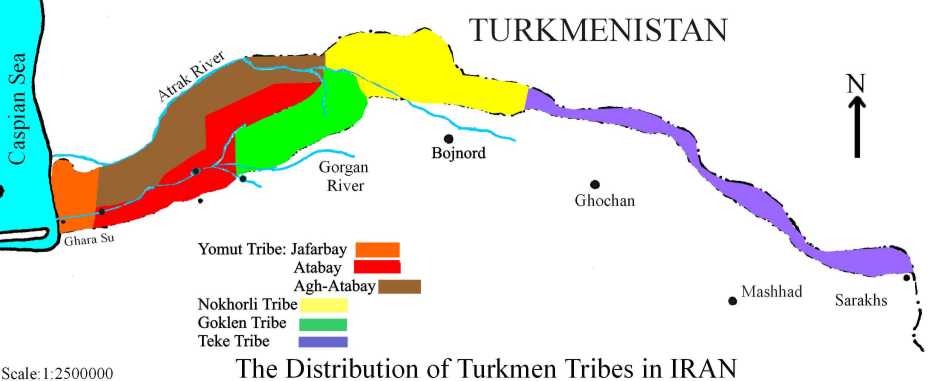





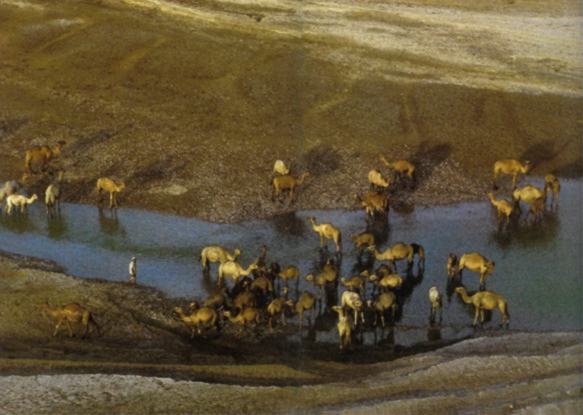
36-37
One of the last of the large groups of camels living in the remote corners
of this land. Now only a reminder of the great migrations of the
past when they helped the cattle-raising Yomut tribes in their summer move
towards the cool Balkhan mountains in Russia and back to the warm plains
of Gorgan in winter. Korand village, by the Atrak River.

38-
The Turkman territories enjoy a variety of climate. Regions close
to Mazandaran province in the north of Iran have a moderate climate with
green hills, fields and thick forests, near Golli Daq.

39-
Autumn rain in Jargalan.

40-
A Yomut hunter, hunting birds at Lake Alagol near Tangli.

41-
Taking the flock for grazing at dawn on an autumn day. Garkaz village,
Jargalân.

42-
The rich green grazing land around Qoyjoq and Oqchi villages. Early
spring, south of Khâled Nabi mountains.

43-
A view of the lush forest covered mountains of Turkman Sahra near Kalâleh.
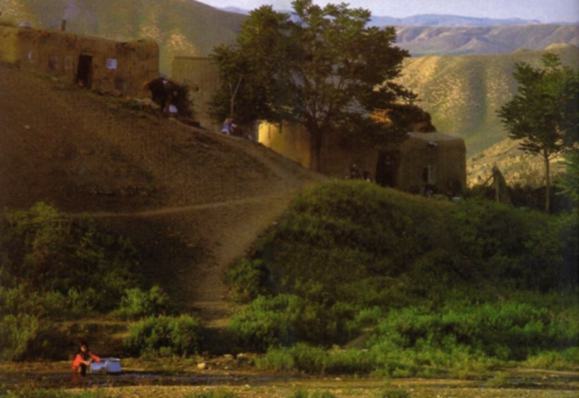
44-45
Washing dishes and taking water from a spring at the "chârvâ"
(summer quarter). Nokhorli tribe, Yekkè Soud village.
This " chârvâ" comprised of a few mud houses is left uninhabited
in other seasons.
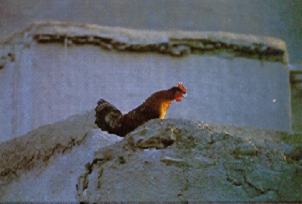
46-
Top Morning has broken, Garkaz village, Jargalân.

46-
Bottom Garkaz village, built by the Garkaz tribe after they migrated
to this area from Russia at the beginning of this century.
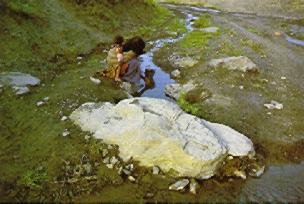
47-
Top- There is a long way to go for every drop of water. A "chârvâ"
belonging to Garkaz village.

47-
Bottom- Start of winter, Garkaz village Jargalân.

48-
A Garkaz woman milking at the "chârvâ " (summer quarter), Garkaz
village, Jargalan.

49-
Boiling milk at day break at the "chârvâ" to make dairy products.
The Nokhorli, Yekkè Soud. Dairy products are prepared by the
women who come with the herd from the village to the "chârvâ
".

50-
A woman from the Guklân tribe at a Guklân " chârvâ".
Jargalan. Yoghurt can be seen hanging in cheesecloth to drain.

51-
A Guklan woman preparing cheese. The modern churn has now replaced
the laborious task of shaking the "mashk". (A mashk is a hide for churning).
Garkaz village, Jargalan.
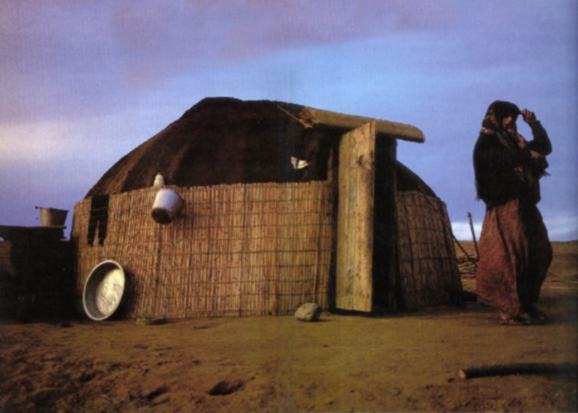
52-53
A Jafarby Yomut woman beside her "qara-gotikma" (tent) a simpler form of
the "qara-oy", the dwelling place of the Yomut nomadic herdsmen near lnchè
Borun. A "qara-gotikma" is simpler and therefore easier to transport
than a "qara-oy" (see photograph 58).
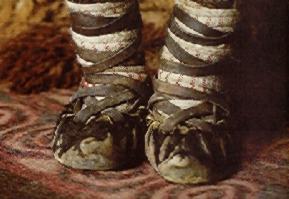
54-
Top: Traditional footwear of the Yomut herdsmen made of rawhide.

54-
Bottom: A Yomut shepherd in a "qara-oy" near Tangli.
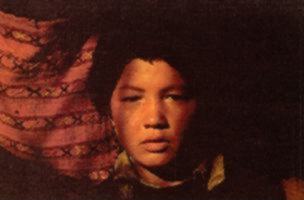
55-
Top: A Yomut shepherd boy near inchè Borun.
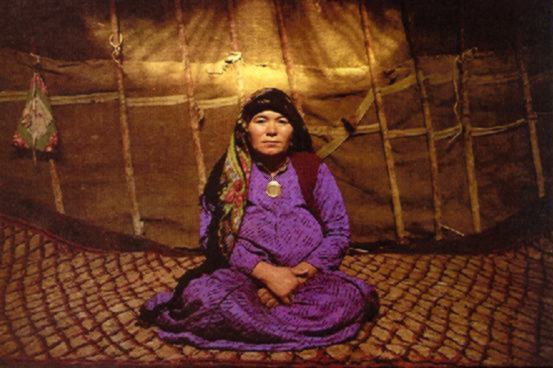
55-
Bottom: An Atabay Yomut- woman inside a "qara gotikma". Yomut
women enjoy more freedom than those of other tribes and their clothing
in also of a simpler nature. Inchè Borun.

56-
A Jafarbay Yomut woman kindling the fire inside a "qara-oy", near Aq-Qala.

57-
Another view of the interior of a "qara-oy" with hides hanging to be dried
and smoked, and ropes to which heavy weights are attached during a storm
to stabilize the tent.
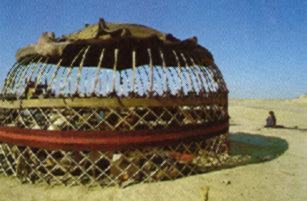
58-
Top: The framework of an "oy", tent of the cattle raising, migratory
tribes of Central-Asia, now used by the semi migratory, cattle raising
Yomuts. It has a dome-shaped framework composed of four frames called
"tarem" which look like cylinders fixed in the ground, and between 60 to
70 cm high bow-shaped wooden struts called "oq" which are joined to the
frame and then at top to a wooden, wheel-shaped piece called "tuynuk".
(the "oy" is covered with straw mats at the bottom and felt mats at the
top). These joints form a dome-shaped structure resistant to wind
and storms. A double door and its frame complete this structure.
The tent is called "aq-oy" at first when the mats are white, and then "qara-oy",
after the mats turn black with age.
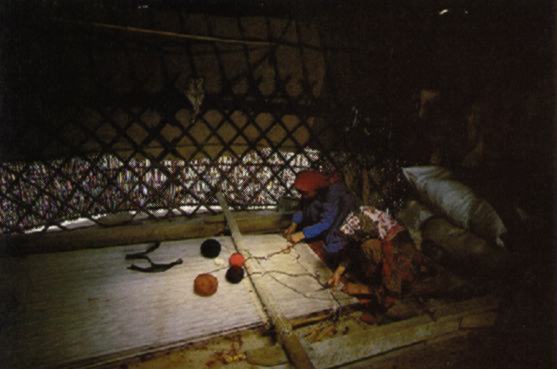
58-
Bottom: Yomut girls weaving rugs inside a "qara-oy", Qoyjoq village.
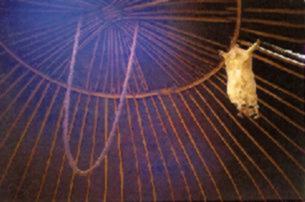
59-
Top: the ceiling of an " oy " where the " oqs " are joined to the "tuynuk".
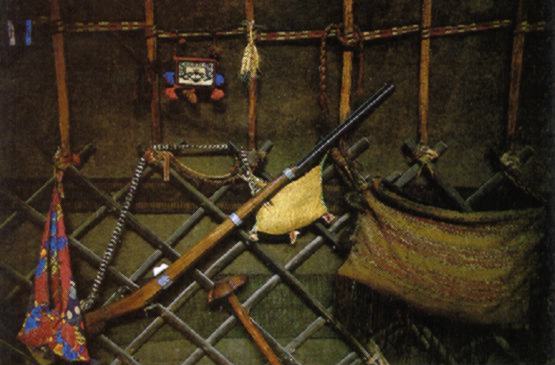
59-
Bottom: A view of the interior of a "qara-oy" showing Yomut hunting
weapons, tools, and herdsmen's equipment.

60-
Metal and wooden talismans, horse shoes etc, hang inside the entrance of
the "oy" to protect the house and its inhabitants from the evil eye.

61
- Life inside a "qara-oy". Yomuts, now inhabiting open plains, used
to live a migratory life based on animal husbandry until the beginning
of the present century. They used to live in Central Asian tents
called "oy", spending the winter time in Gorgan plain where the climate
is mild, and moving to the Balkhan mountains located at the other side
of the Atrak River in the Russian territory by the end of the spring. A
few Yomuts have still preserved their old tradition and migrate from one
area to another on a restricted level. Agri Boqaz.

62-
A cotton field and village houses between Minoodasht and Gonbad-e-Kâvoos.

63-
Mechanized farming around Kalâleh.

64-
Yomut sheepfold near Altin Tokhmâq.

65-
Chapoqli village by the Caspian Sea.

66-
The last Turkman saddle maker with on finished saddles. Tang-e-Turkman
village, Jargalân.

67-
Sesame oil extracting workshop, Garkaz village, JargalAn.
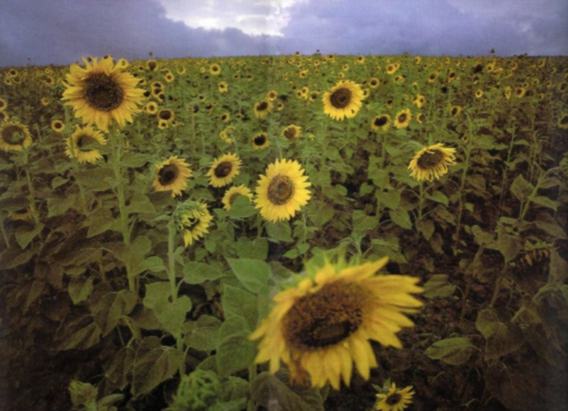
68-69
Plain of sunflowers near Golli Dâq.

70-
Mulberry leaves supplied from mulberry orchards in the nearby village to
feed the silkworms. Tang-e-Turkman village, Jargalân.

71-
Feeding the silkworms at an early stage of their growth. Garkaz village,
Jargalân.

72-
The traditional method of drawing the silk thread off the cocoons, known
locally as "kildan". Garkaz village. Jargalân.

73-
Weaving "qermezi" ; the traditional silk cloth used to make traditional
clothes of the same name. Nowadays very few people weave silk.
Yekkè soud village, Jargalân.
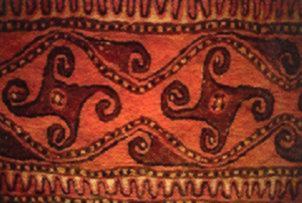
74-
Top- A sample pattern of felt carpet.
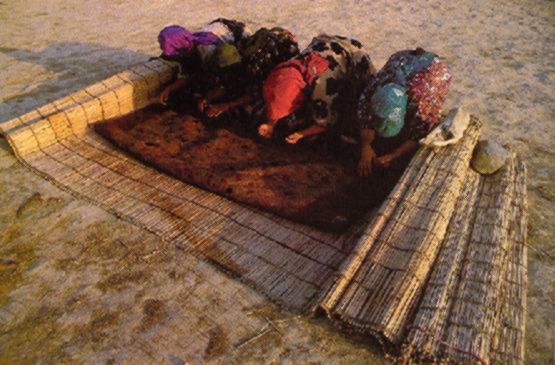
74-
Bottom- Women from the Yomut tribe making a felt carpet called a "namad".
The task need the cooperation of women from related families. Namads
are made in different sizes with decorative mythological designs.
Felt making is a source of income for the family.
Qara Aqachli village, near Marâveh Tappeh.
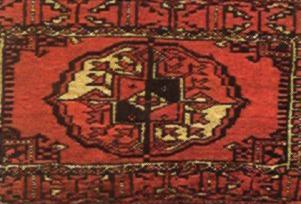
75-
Top: Pattern of a turkman bag.
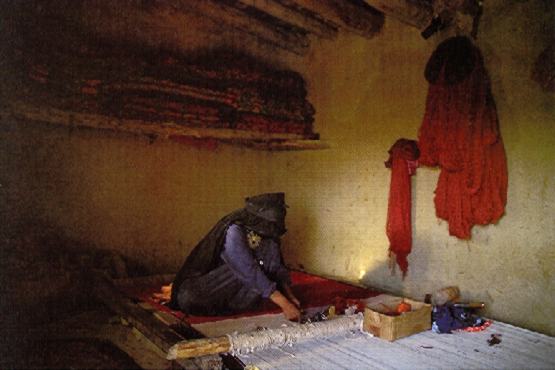
75-
Bottom: A woman carpet weaver, Garkaz village, Jargalân.
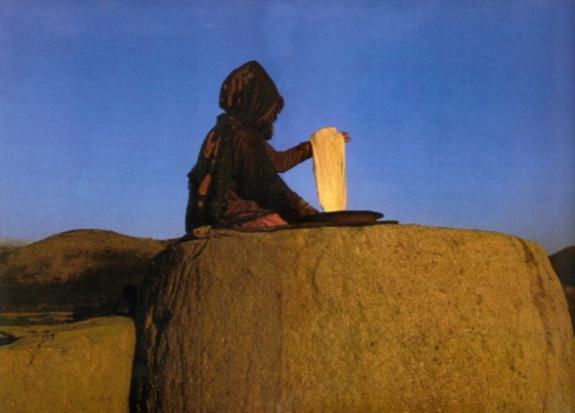
76-77
the bread reflects the setting sun. A Nokhorli woman baking bread,
Karkouli village, Jargalân.
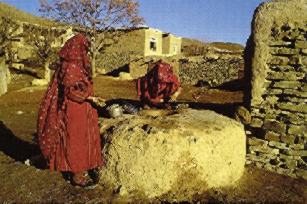
78-
Top: Nokhorli women reparing the oven. The oven is constructed
in the open ground among the houses and is used by a few related families.
Tootli village, Jargalân.
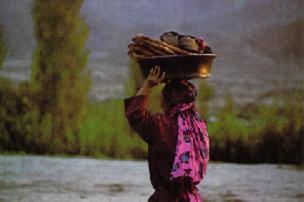
78-Middle:
Lightning the fire in the oven, Garkaz village, Jargalân.
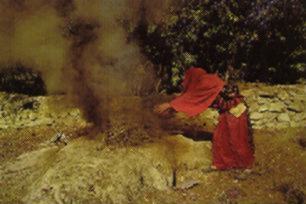
78-Bottom:
A Tekkè woman carrying home baked bread. Dashtak village.

79-
A Nokhorli woman cleaning her house. Mazârliq village.

80-
In their few moments of leisure, they bathe the children with a little
hot water. Garkaz village.

81-
Bathing children with a little hot water in a village house near Tangli.

82-
Nokhor women carpet weavers at the horizontal loom. Carpet making
is one of the major sources of income among the Turkmans. It is a
female task, and a women's skill elevates her status in her family.
Women are regarded as a vital means of earning a family's living.
Marriages are arranged through deals to have access to a woman's labour.
Mazârliq village.

83-
Yomut at the Monday market Bandar-e-Turkman.
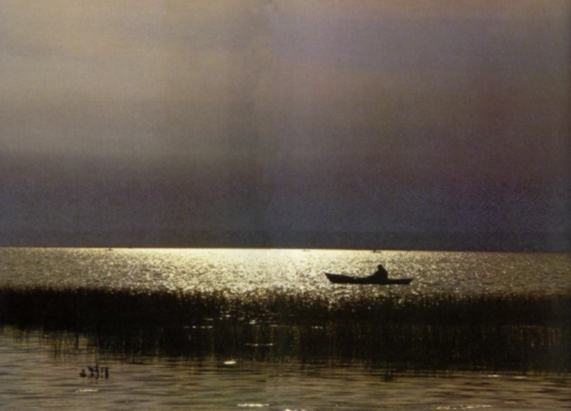
84-85
Bird hunting on Lake Âlâgol near Tangli. In winter many
hunters come here with their muskets from nearby towns and villages.

86-
Waiting to retrieve the fallen prey. According to a tacit agreement
the prey belongs to the person who picks it up. Lake Âlâgol
near Tangli.

87-
A bird hunter at dawn. Lake Âlâgol.

88-
A day's kill. Lake Âlâgol.

89-
Hunter's boats by a Yomut sheep fold. The hunters usually leave their
boats with their relatives and friends between hunts.

90-
Fishermen having breakfast at dawm before a day's sturgeon fishing, near
Âshurâdeh.

91-
A fisherman stunning a sturgeon to prevent it from jumping back into the
sea after it has been pulled into the boat. Caspian Sea, near Âshurâdeh.
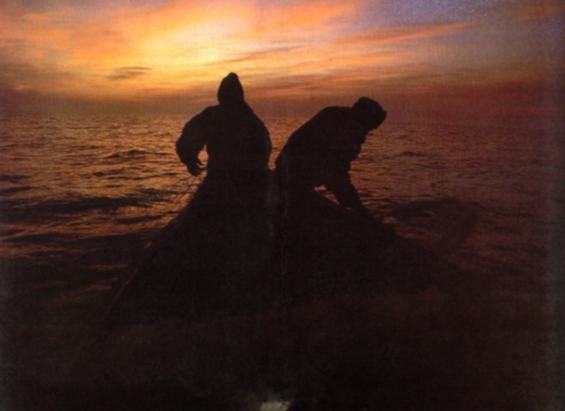
92-93
Inspecting fixed nets used for catching sturgeon, near the lrano-Turkmensitan
border.
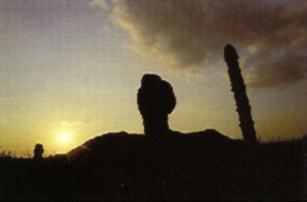
94-
Top: Phallic and ramhorn shaped stones on ancient-graves. A graveyard
near Khâled Nabi Shrine.
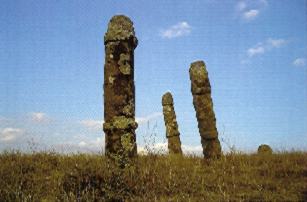
94-
Middle: Phallic and ramhorn shaped stones on ancient-graves.
A graveyard near Khâled Nabi Shrine.
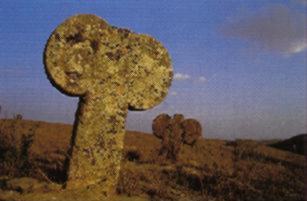
94-
bottom: Phallic and ramhorn shaped stones on ancient-graves.
A graveyard near Khâled Nabi Shrine.
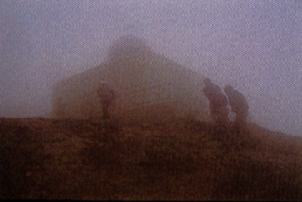
95-
Top: Turkman pilgrims on their way to the Khâled Nabi Shrine.
This shrine on the summit of Gukchedâq mountain is the burial place
of Khâled Nabi a religious figure much revered by the Turkmans.
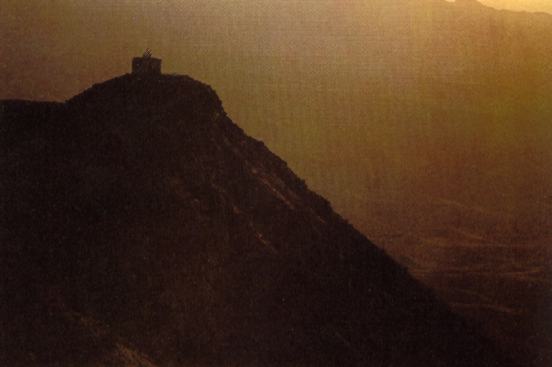
95-
Bottom: The tomb of the shepherd and faithful servant of Khâled
Nabi who was buried at the foot of his master's grave as requested in the
holy man's will.

96-
Petitions left at the tomb of a martyr near Qoshè Sou.
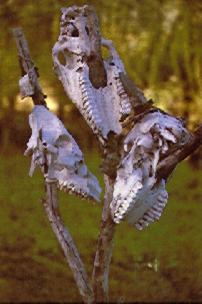
97-
Top Right: Skulls of cows hanging to ward off evil spirits and the
evil eye. A farm, Jargalân.
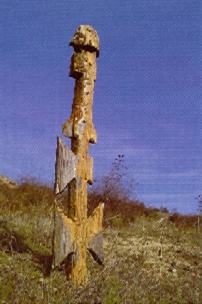
97-
Top Left: Wooden statues of birds of prey erected on ancestral graves
near Gharnâveh.
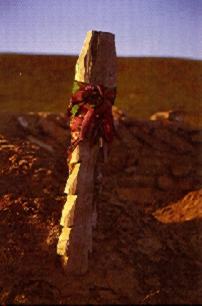
97-
Bottom Right: Wooden statues of birds of prey erected on ancestral
graves near Gharnâveh.
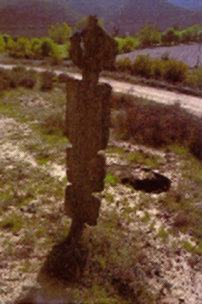
97-
Bottom Left: Wooden statues of birds of prey erected on ancestral graves
near Gharnâveh.

98-
Erjab Porkhân, the wizard, conducting a ceremony called Porkhân,
seeking the help of his supportive angel to exorcise the evil spirits possessing
the patients. A sword dance accompanied by a melody played on the
"dotar" (a type of musical instrument) completes the ceremony. This
ritual dates back to the early Turkman religions and is a reflection of
their believes. Yeal Cheshmeh near Qarânki Jangal.

99-
Local elders and clergy gathered in front of the. house of the deceased
to sympathize with the mourners, Jargalân.

100-
The interior of a mosque showing the Turkman mythological ramhorn design.
Turkmans are sunni Moslems and their religious leaders who are called "Âkhouns"
mostly undertake the instruction of the students of theology, besides conducting
religious ceremonies. Qabelqâ village, Jargalân.

101-A
ramhorn shaped capital on a wooden column in the porch of a house.
Qabelqâ village. Jargalân.

102-
Cutting and drying the meat of a scarificed sheep on Eid-e-Qorbân.
Yekkè Soud village, Jargalân.

103-
Making "qormeh" (preserved meat) for winter use with meat left over from
the Eid-e-Qorbân sacrifice. Jargalân.

104-
There is no other way but to shake sin off one's shoulders. During
the three days Qorbân holiday, all people regardless of their age
or sex, ride on swings towards the heavens to purify themselves of sin.
Doydokh village, Jargalân.

105-
Singeing the head and feet of the sacrificed sheep and preparing them for
cooking, Jargalân.

106-
Making "cholfak" (a kind of pancake) for a feast, Jargalân.

107-
Circumcision of a young Tekkè boy. Wealthy Turkman families
usually hold a party which includes horseracing and wrestling to celebrate
this event.
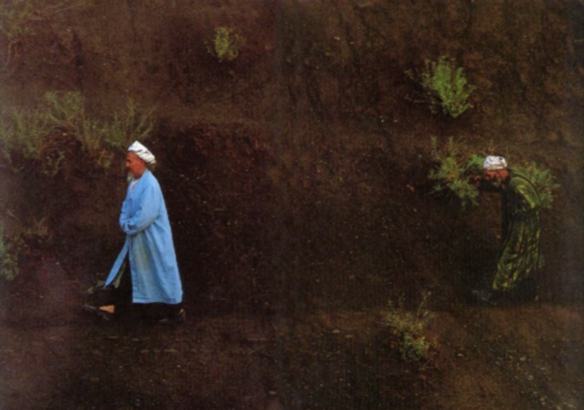
108-109
The master and the diciple. Âtâ Ishân and his follower
on their way to the Feast of scarifice (Eid-e-Qorbân). This
great Islamic feast in which an animal must be sacrificed is held at the
end of the Haj. Garkaz village, Jargalân.

110-
"Saffar-Mohammad-e-Mohammadi" a smuggler from the Tekkè tribe who
spent seventeen years in prison and exile in the Soviet Union charged with
smuggling, now among his relatives in the small village of Doydokh after
crossing the border.
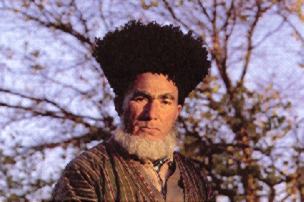
111-
Top: Ashur Mohammad-e-Seis, a horse trainer and a "bakhshi" (dotar
player) from the Alili tribe.
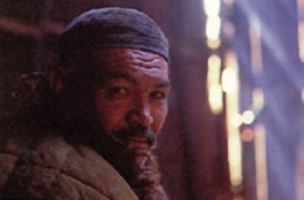
111
- Middle: A Yomut herdsman near Inchè Borun.
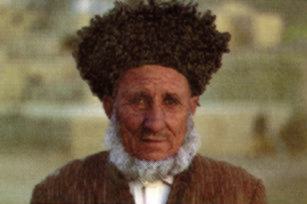
111
- Bottom: A Nokhorli man. Mazârliq village.

112-
"Through the frame". A girl from the Tekkè tribe, Doydokh
village.

113-
A Garkaz girl wearing girl's costume and ornaments.

114-
The face of a Nokhorli woman wearing a Yashmaq or covering for the mouth
and chin. (The Turkman believe that the breath of a married woman belongs
solely to her husband) Mazârliq village, Jargalân.

115-
A Garkaz woman in traditional costume and ornaments, Jargalân.

116-Khani
Tekkè, one of the last of the Turkman silversmiths. Gonbad-e-Kâvoos.

117-
Details of a "boqow" (a pectoral ornament made of silver and studded
with carnelians weighing approx. 1.5 kg. and measuring 28x25 cm.)
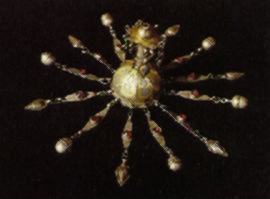
118-
Top Right: Young girl's headdress,"qobbah,Tekkè.
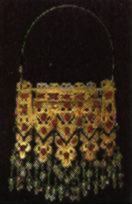
118-
Top Left: Pectoral ornament, "boqow", Tekkè.
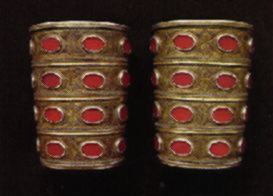
118-
Middle Right: Bracelet,"bezelik", Tekkè.
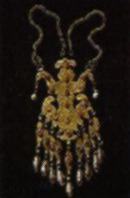
118-
Middle Left: Hair ornament,"athekh", Tekkè.
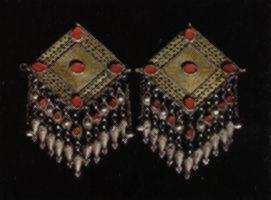
118-
Bottom Right: Clasp of a woman's coat,"changah", Tekkè.
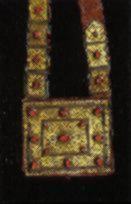
118-
Bottom Left: Amulet "heykal",' Quran container, Tekkè.
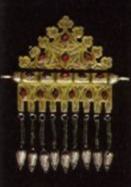
119-
Top Right: Amulet,"tumar" one of a pair, Tekkè.
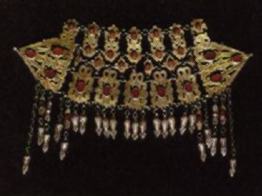
119-
Top Left: Headdress ornament - "ildirqich".
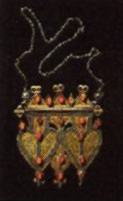
119-
Middle Right: Hair ornament,"athekh", Tekkè.
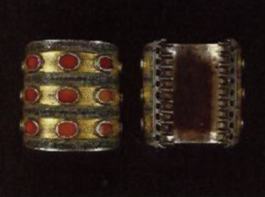
119-
Middle Left: Bracelet "bezelik", Tekkè.
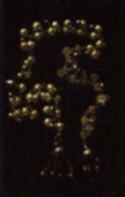
119-
Bottom Right: Ornament for plaited hair "qorbaqeli monjooq".
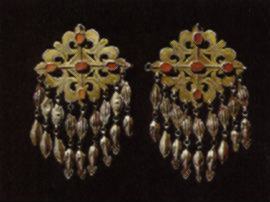
119-
Bottom Left: Clasp of a woman's coat, "changah", Tekkè.
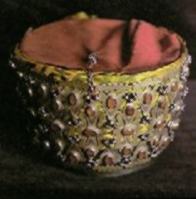
120-
Top Right: The ornamented headdress of Tekkè women.
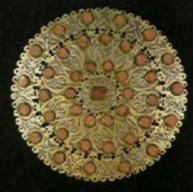
120-
Top Left: Collar stud, "gol yaqeh".
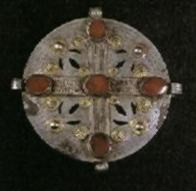
120-
Middle Right: Tekkè Pectoral ornament.
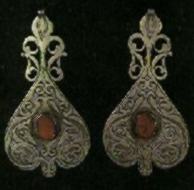
120-
Middle Left: Headdress ornament, temple pendant, "tenchir" or earrings,
Tekkè.
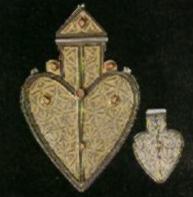
120-
Bottom Right: Hair ornament, "athekh" ,Tekkè.
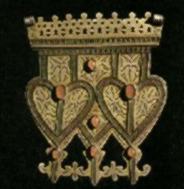
120-
Bottom Left: Hair ornament "athekth" ,Tekkè.

121
- The front of a woman's coat (chapraz) with silver medallions and lozenges.

122-
A Tekkè woman in traditional red silk shift (koynuk) with an embroidered
headdress (kurteh) part of a pectoral ornament can be seen under her Yâshmâq
- Doydokh village, Jargalân.

123-
Back view of traditional costumes worn by Garkaz women, Garkaz village,
Jargalân.
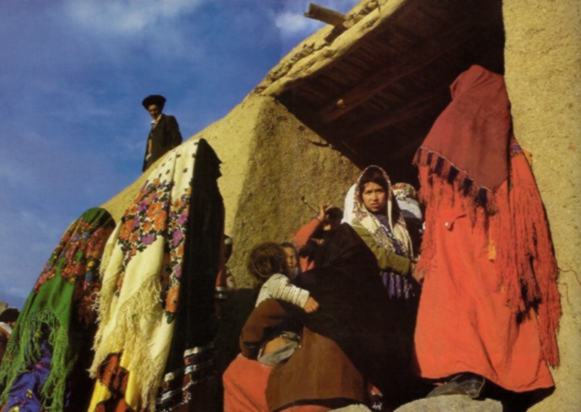
124-125
A wedding, Jargalân area. Turkman wedding celebrations usually
continue for three days and nights. On the third day if the bridegroom
is from a wealthy family, horseraces and wrestling matches are held.

126-
The bridal procession on its way to the groom's house. Garkaz village,
Jargalân.

127-
Once at the bridegroom's house, flour is poured under the bride's feet
and coins showered on her head, while coins and candy fly into the air
among the guests. Qara Aqai village Jargalân.

128-
The bride surrounded by her relatives enters her future home. Qara
Aqaj village.

129-
The bridal chamber at the groom's house showing the curtain behind which
the bride sits. Qara Aqaj village.

130-
Two newly-wed Guklan brides in their traditional Turkman costumes.
Inche, one of the oldest Turkman villages.
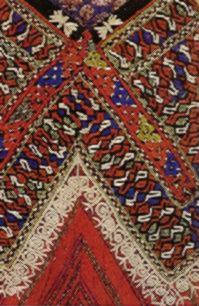
131-
Top Right: Richly embroidered trouser cuffs.
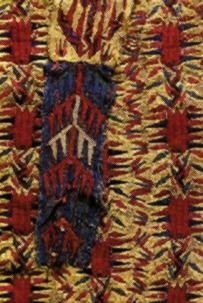
131-
Top Left: A detail of a woman's headrobe (charpi) like the " kurteh",
but heavily embroidered.
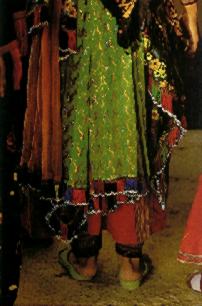
131-
Bottom Right: Part of Guklan woman's costume.

131-
Bottom Left: A dotar (tam-dreh), a favourite musical instrument of
the Turkmans.
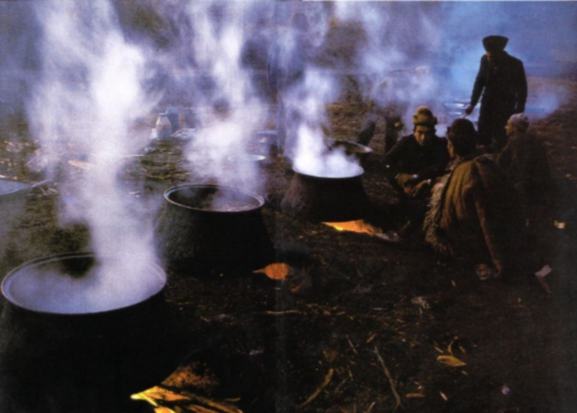
132-133
Preparing food for the wedding. Garkaz village. Jargalan.

134-
The highest board of decision making; at the wedding ceremony. The
elders and the clergy sit around a table cloth decorated with various types
of bread, each having a bowl and a teapot before him. All decisions
are made here. To avoid paying "Shirbaha" (The money given to the
girl's family upon marriage), two girls are exchanged; a 14-year-old boy
and a 13-year-old girl for a 14-year-old girl and a 5-year-old boy.
Garkaz village.

135-
The night of the feast. Men gathered around the fire, sitting on
flet mats on a cold autumn night, breaking the coldness of the night with
their songs accompanied by the" dotar". Karposhli village.
Jargalân.

136-
Riders from villages far and near on their way to take part in a horse
race. Atrak river near Dashtak village.

137-
The Turkman has the love of horse in his blood. The horse is a symbol
of an invading war-like people. It is a reminder of the olden days
when they swept across great deserts, leaving mountains and steppes behind.
The days of the raids are over but the horseraces held for feasts and weddings
are no less exciting. A gathering of the elders, the judges and horse
trainers, discussing the competitors taking part in each horse race.
Dashtak village.

138-
Warming up the horses before the race. Inchè village.

139-
A natural stadium consisting of a plain surrounded by hills where the horse-races
take place. Men and women take their seats separately on opposite
hills. Karposhli village.
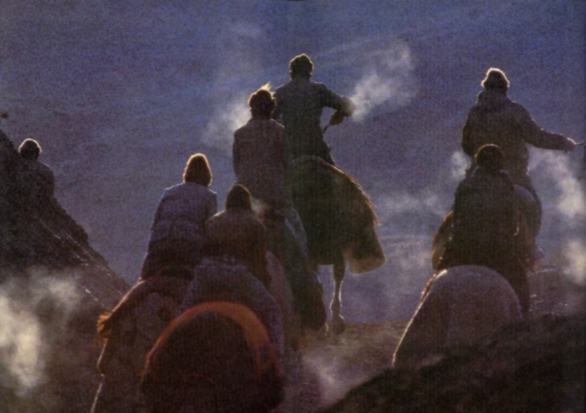
140-141
- An early morning practice to warm up the horses before the race.
Inchè village.
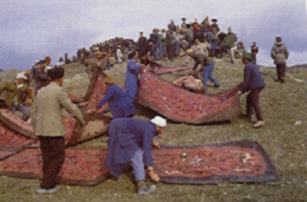
142-Top:
Before the horse races begin felts are spread for the elders (yashuli)
and clergy to sit on. Garkaz village, Jargalân.
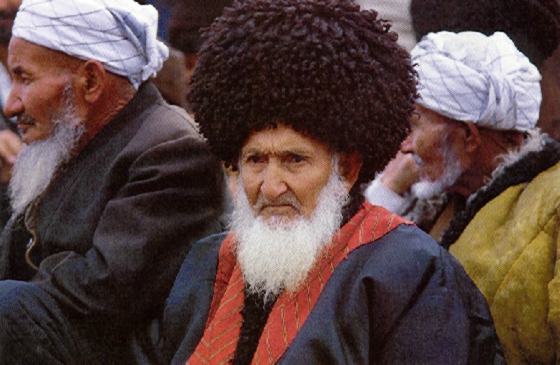
142-Bottom:
A Nokhorli elder (yashuli) attentively watching the race. Karposhli
village. Jargalân.
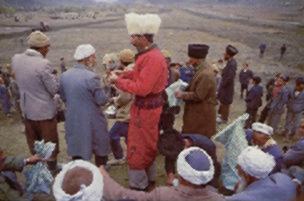
143-Top:
A Guklan man in traditional costume announcing the prizes and prize money
(qatanj) to be given to the winners of the horse race. Karposhli,
argalân.
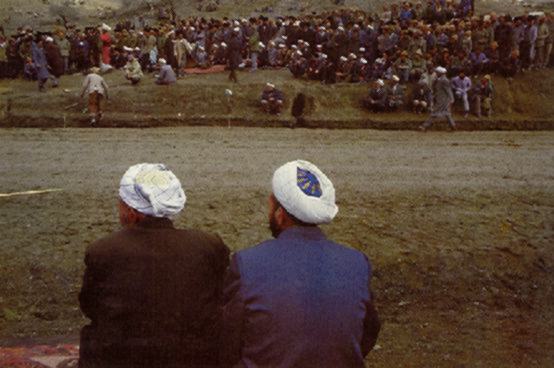
143-
Bottom: The judges (amin) of the horse race waiting at the winning
post to announce the winners. Karposhli, Jargalân.

144-
Riders on sturdy horses taking part in an endurance race. In this
part of the race the riders circle the track four to eight times.
Qara Aqaj Village, Jargalân.

145-
Enjoying a horse race. Garkaz village, Jargalân.
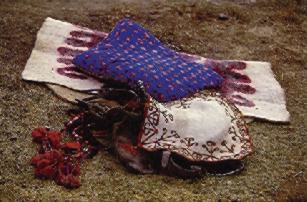
146-Top:
The saddle and trappings of a horse brought in for the race.
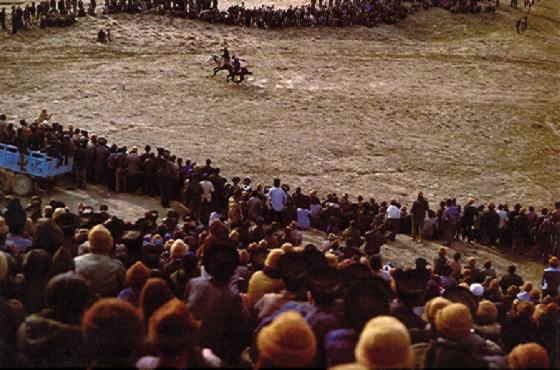
146-BottomFirst
section; two young horses racing along the straight path. Garkaz village.
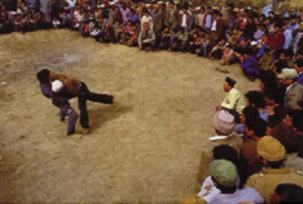
147-Top:
After the horse race wrestling begins. The wrestlers are allowed
to hold each other by the belt only. In this way each tries to floor
the other using any of the four approved techniques. Orjanii village
near Kalaleh.
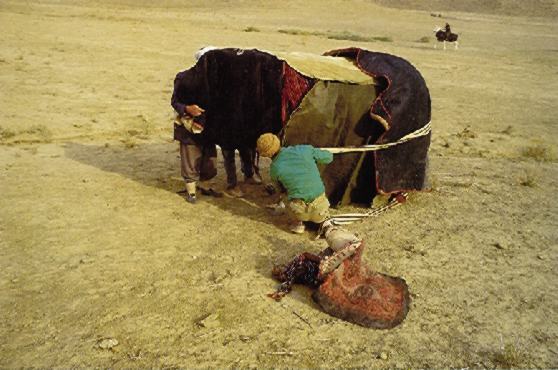
147-Bottom:
The trainer covers the sweating horse with felts and horse blankets to
protect it from the North Wind. The horse continues to sweat under
the warm coverings and thus rids its body of toxins. The trainer
checks the decreasing level of the toxins by tasting the sweat of the horse
and removes the coverings one by one accordingly. This is called
sweetening (the horse sweat ) Karposhli village, Jargalân.
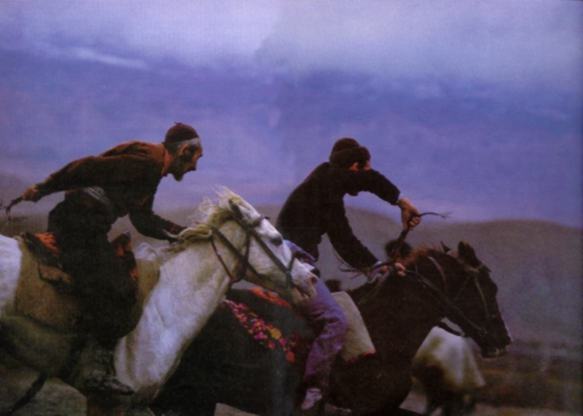
148-149-
"They're off!" Second section' a race using well-trained strong horses.
Inchè village.

150-
The walled village of Qabelqa in winter. (Qabelqa in Turkman means shelter
or gathering in a shelter) The verandah is the only passage connecting
the rooms each occupied by a single family.

151-
On route from one village to another. Jargalân.

152-
A view of several village houses located between Yekkè Soud and
Karposhli.

153-
A view of Karkouli village, Jargalân.

154-
An elderly villager returning from a party, Jargalân.

155-
Ata Ishan the village religious figure and mystic in his study at the Theological
School. Garkaz village.

156-
The interior decor of a house. Bachè-Darreh village.

157-
A niche in a Nokhorli house. Qabelqa village, decorated with triangles
believed to have talismanic power.
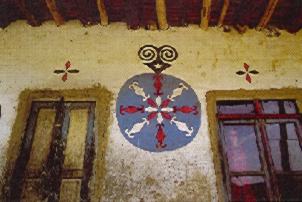
158-
Top: Stylized paintings of the sun and ramhorn designs on the walls
of village houses. Jargalân.
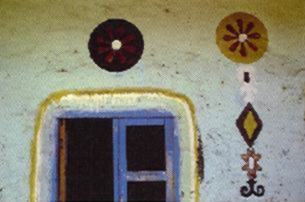
158-
Middle: Wall decoration paintings of a house at bacpolad village. At
one times, these paintings were used to save the residence of the house
and to repel the wickedness.
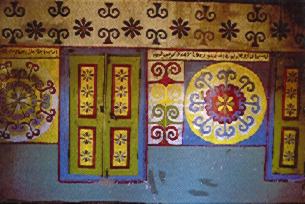
158-
Bottom: Wall of a room in bacpolad village. Ramhorn which is horn of
plenty can be seen evrywhere.
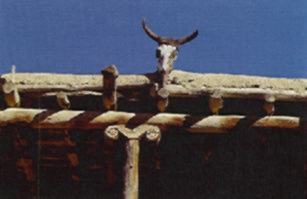
159-Top:
The skull of a cow placed on the roof of a house to protect the house and
its inhabitants from the evil-eye.
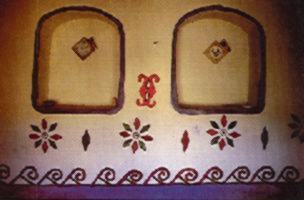
159-Middle:
The interior decor of a room in the Nokhorli village of Qabelqa.
![]()
159-Bottom:
The porch of a house. Bak Poulad village.

160-
The porch of a house in the Tekkè village of Dashtak.
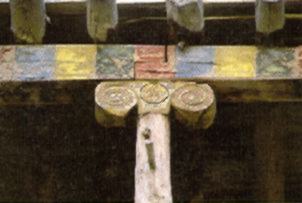
161-
Top: Ramhorn shaped wooden capitals in Doydokh village villages.
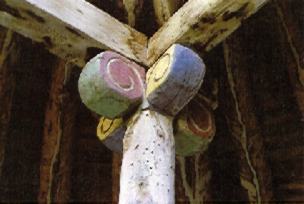
161-
Middle: Ramhorn shaped wooden capitals in Doydokh villages.
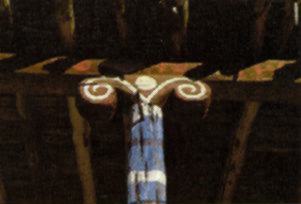
161-
Bottom: Ramhorn shaped wooden capitals in Yomuq villages.
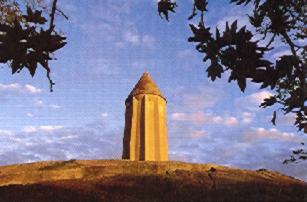
162-Top:
The tomb of Abu-al-Ma'ali Qabus Ebn-e-Voshmgir one of the Al-e-Ziar Sultans
with a height of 52 meters. dating from 397 A.H. (circa 1018 A.D.) in the
town of Gonbad-e-Qabus (Kavoos)
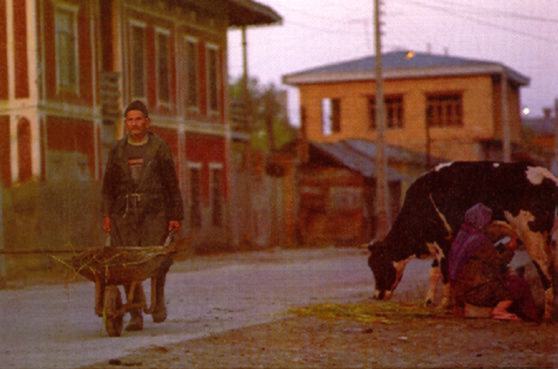
162-
Bottom: Gomishan a Turkman town with Russian style wooden houses.
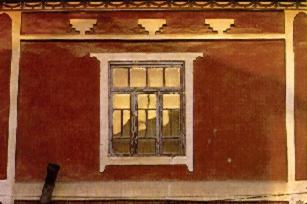
163-Top:
The window of a wooden house. Gomishan.
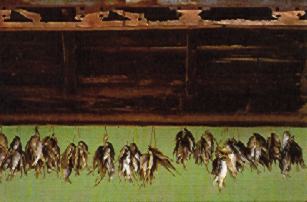
163-Middle:
The porch of a wooden house in Khajeh-Nafas. Fish can be seen hanging
up to dry.
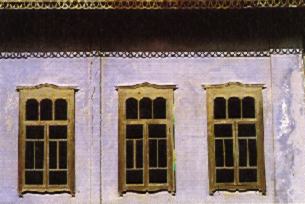
163-Bottom:
The windows of the deserted Russian Consulate at Gomishan.
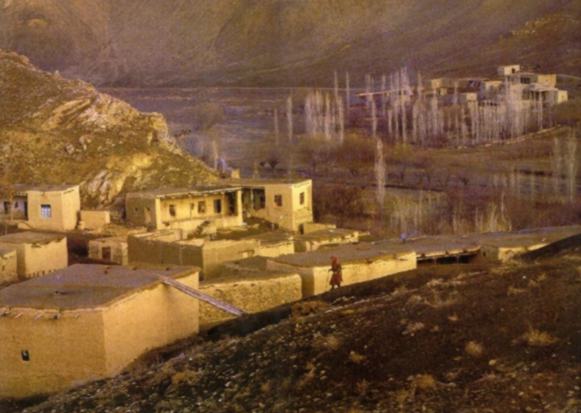
164-165
Garkaz village in early winter.

166-
A Guklan woman in Garkaz costume. Jargalân.

167-
A Garkaz woman. Even though she is neither noticed by any one, nor
takes any notice of others, she reacts as if she has been caught naked
before the camera. Garkaz village.

168-
Makhtoum Qoli, the sixth generation descendant of Makhtoum Qoli Faraghi,
the much loved Turkman poet, sitting under a portrait of the poet.
Garkaz. Jargalân.

169-
A Nokhorli man from Yekkè Soud village, Jargalân.

170-
A woman and her daughters. Garkaz village, Jargalân.

171-
A clergyman and his family Tekkè tribe. Doydokh village.
Jargalân.
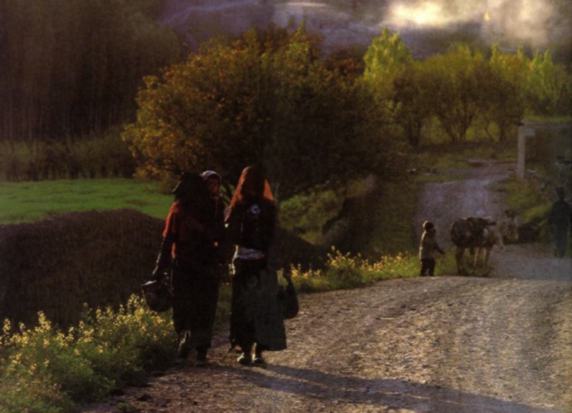
172-173
On their way to visit relatives. Jargalân.

174-
An elderly Turkman with his grand daughter. Jargalân.

175-
Young girls help run the house from early childhood Gozbâshi village.

176-A
young Yomut girl near Marâveh Tappeh.

177-Some
Turkman believe that if they do not shave their children's head, they will
not grow. Baqloq village. Jargalân.

178-Young
shepherdesses on their way to the village. Jargalân.

179-
A Guklan village in Golidaq district.
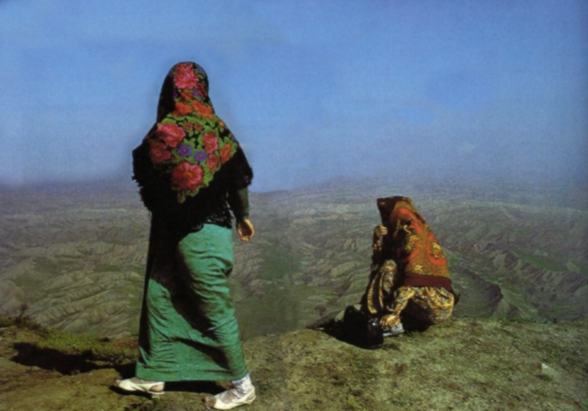
180-181
Town dwelling Yomut girls from Gonbad Kavoos at the shrine of Khaled Nabi.

182-
Boys and girls studying at a five from School Garkaz village. Some
Turkman do not approve of their daughters attending school.

183-
A young girl from a town dwelling Turkman family.

184-
ByBy
| Founded
& Designed by:
Dr. Farzad MARJANI, Civil Engineer, Ph.D. Ankara - TURKEY |
TEL
: +90 - 312 280 82 16
FAX : +90 - 312 280 67 20 EMAIL : farzad@turkmens.com |